The British Rail Sandwich
One of you cats is quite the joker. How does a British cultural reference that’s 20 years out of date end up on the List of Sandwiches that I had, until now, presumed were meant to be eaten? For the click-disinclined, before British train lines were privatized beginning in 1994, they were managed by a single corporate entity known as British Rail, who were famous for selling terrible sandwiches. Or at least, people made jokes about their terrible sandwiches. Douglas Adams said British Rail sandwiches were kept soft “by being regularly washed and resealed in clingfilm.” According to Bee Wilson’s Sandwich: A Global History
In 2002 a thirty-year-old document was dug up revealing the original British Rail catering instructions for sandwiches. It confirmed what rail travelers had always suspected: that the caterers sought to get away with the meanest portions of fillings possible. The instructions advised stacking the filling on the middle of the lower slice of bread, so that when cut in half it would seem fuller than it really was.
I managed to find a photo of this document, which is apparently genuine.
The text:
Preparation of Sandwiches
1. Cream the butter to a smooth and even consistency to facilitate spreading
2. Ensure that the butter covers the whole of the surface of the bread
3. Place approximately two-thirds of the filling to cover the whole of the surface of the bread
4. Place the remaining third of the filling diagonally across the bread where the cut is to be made
5. …ensure that a good proportion of the laid-down quantity is also laid diagonally across the bread where the sandwich is to be cut. This will enable a customer to identify easily the sandwich filling, in addition to improving the appearance.
Bread
It is recommended that a cut loaf giving a slice of 4 1/2″ x 4 1/2″ should be used. With machine slicing it is possible to obtain an average of 44 slices 5/16″ thick from a 3 1/2 lb sandwich loaf.
Butter
The amount of butter to be used for each half-round sandwich or normal roll is 1/6 oz.
Rolls
A Bridge roll weighting 1 3/4ozs, or Ham roll weighing approximately 1 3/4 ozs, is recommended where filled rolls are sold.
Sandwiches
| Category | Filling | Content of filling Half-round sandwich |
| Cheese | Cheddar | 1 oz |
| Blue Danish | 2/3 oz | |
| Salad | Tomato & Lettuce | Tomato 1/2 oz + Lettuce |
| Mustard & Cress | 4 sandwiches to 1 punnet | |
| Cucumber | 1 1/3 oz | |
| Tomato | 1 oz | |
| Poultry | Chicken | 2/3 oz |
| Turkey | 2/3 oz | |
| Egg | Egg | 1/2 Egg |
But do people still joke about it?
I guess they do.
I really could think of nothing to say about this topic, so I interviewed a couple of my British friends to get their thoughts about British Rail sandwiches. First I talked to my friend Ian, notorious Briton and enemy of open-faced sandwiches everywhere @SandwichMeats
Hey Ian, can I ask you a series of dumb questions? It’s for a post on my dumb sandwich website
SM: Sure man, go ahead
You’re an English guy. You’re kind of young though, and I understand this reference is dated by 20 years. Do people still make jokes about British Rail Sandwiches? Any annoying uncles, etc., who make those kind of jokes?
SM: I can’t say I’ve ever heard much of that
It seems weird that people would still be making those jokes 20 years after British Rail ceased to exist, but I actually searched Twitter and found recent references. People never let go of a bad joke I guess.
So let’s say you’re at a bus station or airport terminal or similar and you’re getting a sandwich that’s been wrapped in plastic for the better part of a day (or longer). Which sandwich are you getting?
SM: Like do we have a name for it?
I mean, what’s in it, which one are you choosing?
SM: Probably cheese and ham. Or chicken, bacon and mayo.
Those both sound pretty good actually. What kind of cheese would be in that? Cheddar?
SM: Yes, almost certainly cheddar

OK thanks. Bonus question: what the hell is cress?
SM: It’s an edible leaf. It seemed to be on all the sandwiches in school as a kid. Egg and cress is a popular British sandwich
Yeah, I’ve heard of those, which is why I was asking. Would you say it is at all similar to arugula? (I guess it’s called rocket over there)
SM: It has a similar peppery taste, i guess
OK thanks man.
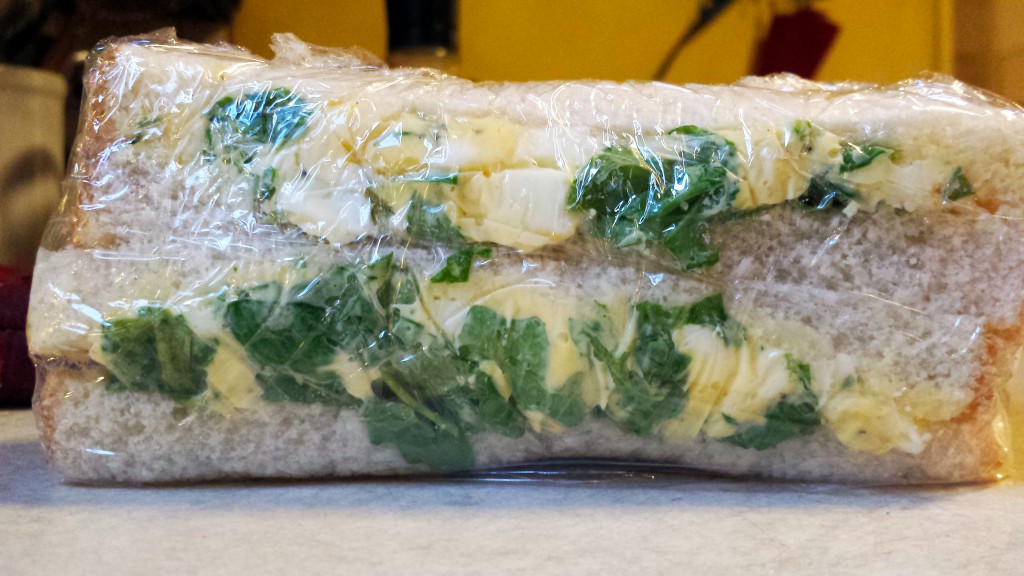
So far, so good. These sandwiches didn’t look too bad, except that apparently in England they don’t put mustard in their egg salad, only mayo & a little salt and pepper. Still, that chicken and bacon sandwich actually looked pretty good, and the ham and cheese should at least be edible. I spread a microscopic amount of butter on each slice of bread before adding the sandwich filling, and cut them in half along a diagonal line where I’d added extra filling. And of course, I wrapped them in plastic clingwrap to provide the proper ambience.
Feeling psyched about this post, I thought I’d find another Brit to harass. I talked to my friend Steve, the ambiguously British Chicago beer nerd @TedwardBouillon.
Hey man can I ask you a series of dumb questions in service of a dumb post for my dumb sandwich website?
TB: Ask away, dummy
You’re English, right? ’cause you don’t sound English/British/whatever that I’ve noticed but I thought I picked up on that.
TB: I was born in England and remain a British National. Yes.
How long have you been over here?
TB: I’ve lived in the US roughly 25 of my nearly 31 years of existence.
Do you think the British sense of humor (I’m sorry, humour) is genetic? (I did say the questions would be dumb)
TB: If a sense of humor was part of our DNA then genetic engineers could make people a lot more tolerable.
So do you remember your family ever joking around about British Rail sandwiches?
TB: I don’t think my hippy parents would have paid to eat sandwiches on a train. I’ve not heard of this phenomenon.
It’s kind of a weird thing to be on our List since it’s a dumb joke about something that stopped existing 20 years ago.
Anyway, are there any particularly British sandwiches that you remember having growing up that your American friends would think are strange?
TB: Yes, I’m quite fond of packaged sandwiches from Marks and Spencer.
I went to England once with a girl I was dating and she got upset and said “all these sandwiches have mayonnaise in them!”
Note to self: put mayonnaise in everything.
TB: Chicken and stuffing?

TB: Anything with curry in it? Americans would likely be perplexed. The average American, anyway.
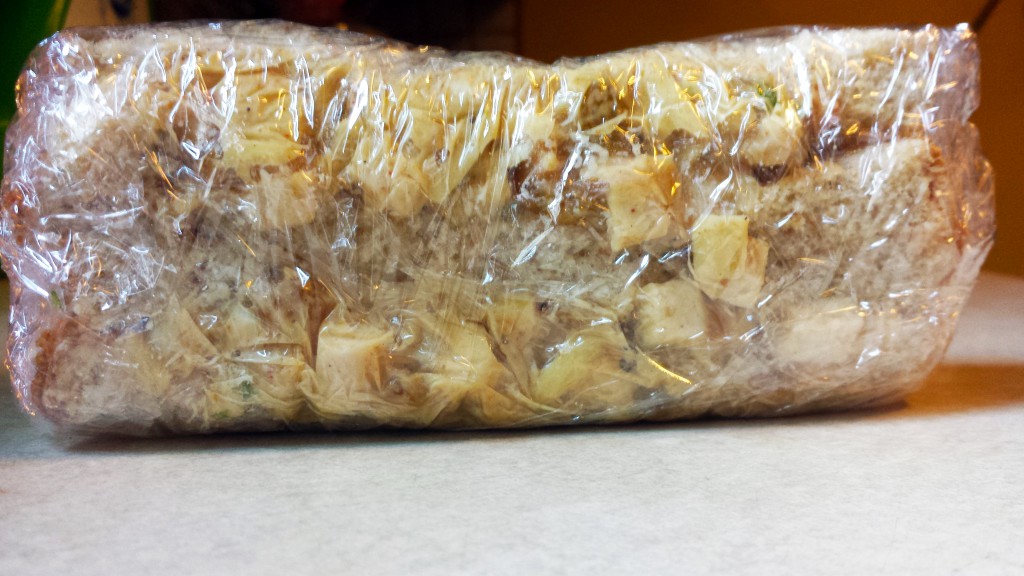
TB: You’d be hard pressed to find a peanut butter sandwich in the isles.
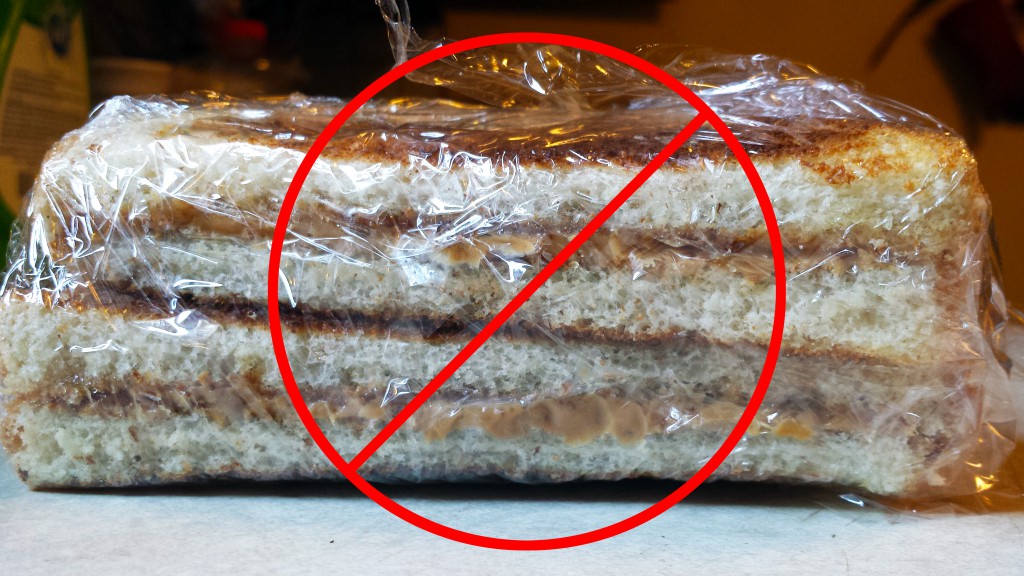
TB: And don’t get me started on Marmite.

No, it’s a Marmite sandwich. Its very existence is ruinous. You son of a bitch.
OK, so let’s say you’re in England, at an airport terminal or a bus station or similar, and you are buying a sandwich that has been wrapped in plastic for the better part of a day (or longer). What’s in the sandwich?
TB: Yes, for some reason I trust that in most places in England, but not at all in the US. I’d go for like a sausage sandwich or chicken and bacon. I’m not much of a ____-salad sandwich guy.
What kind of sausage would be in one of those?
TB: Who knows. Just ‘sausage’. Don’t ask, don’t tell.
Fair enough.

Bonus question: What the hell is cress?
TB: Watercress?
As in “egg and cress sandwich.” You never hear of this type of thing around here, or at least I don’t. Is it a thing I can get at a store? It’s some sort of green leafy thing right?
TB: It is.
You’ll find similar greens on a bahn mi. It’s not that weird. No weirder than sprouts.
I’m not sure of the availability of watercress here, or whether it goes by another name.
Like how they call arugala “rocket” in England.
Alrighty, thanks man
TB: Hey, anytime. I’m just a common British man living in an American world.

Each of these lovingly handcrafted sandwiches was wrapped in plastic and stored in the refrigerator for periods of time ranging from several hours to overnight. Then, because there were 8 sandwiches and only one of me, and also because I am an utter bastard, I had my wife and kids help me eat them. The 7 year old got the peanut butter sandwich, mostly because I didn’t want to be arrested for child abuse. I explained the project to them and we tried the sandwiches in roughly the order they were mentioned above.
Cheese and ham: Not much to comment on here. A couple of us were surprised by how salty it seemed. Little did we know. The 17yo later commented that this was his least favorite of the sandwiches. Obviously that was Before Marmite. Still, it was soggy from 24 hours in plastic and I’d have to rate it as mediocre-to-bad.
Chicken and bacon: This sandwich was every bit as good as I thought it would be. An early favorite, and I can see myself making more of them. This is a Good Sandwich.
Egg and rocket: “Bland,” remarked the 14yo. I was definitely missing the mustard, as I thought I would. This sandwich was one of Mindy’s favorites, possibly because of the arugula. In my opinion, though, this was a poor sandwich.
Chicken and stuffing: Not bad, not as weird as I thought, but it would have been better with good homemade stuffing instead of the cheapo stovetop-type I used. The fattest and soggiest of the sandwiches, though. Edible but avoid if possible.
Coronation chicken: Another favorite, at least for Mindy, the 17yo and myself. The 14yo said it was a bit too sweet for him. The 7yo asked to try it also as he’s a big fan of golden raisins, but he didn’t care for the sandwich and it was finished by others. In a bit of ominous foreshadowing, I casually remarked that we hadn’t had a single sandwich hit the trash can yet. This one, however, was a Good Sandwich.
Marmite and cheese: All good things come to an end I guess. The 14yo and Mindy took one tiny bite each, spit them into the trash, and chucked their sandwiches in right after. The 14yo said I was right about the sandwich being child abuse. I shook my fist at him menacingly and told him to shut up if he knew what was good for him. The 17yo and I finished our portions out of pure stubbornness. He looked me in the eye after his first bite, said “Nope. I don’t like it,” and then proceeded to hate-eat the rest of it. He said the Marmite tasted like fermented bouillon cube, which is pretty much the way I described it when telling Steve off. This sandwich was shit.
“Don’t ask” sausages: The 17yo’s eyes widened in legitimate fear when I said there was another sandwich–he must have thought I saved something even worse than the Marmite for last. I hadn’t–the sausages were fine, but cold sausages aren’t that appealing and our palates had been ravaged so severely by the Marmite that they could have been lumps of lard for all we could taste them. This was also a bad sandwich.
Look, England, you invented the sandwich, right? Or at least the word sandwich! Well, it’s the English language, I guess you invented all the words. Still, you can do better than this, I hope! I’m pretty sure there are good sandwiches in England, but of course the entire point of the British Rail sandwich is that they are not good. So with a couple of exceptions, I’d have to say we succeeded there.
Steve checked in with his parents and it turns out they did have a bit to say on the British Rail sandwich.
TB: Asking my mum about rail sandwiches. She has indeed had her share.
She says “Well certainly they were a joke; soggy white bread with squished-down cheese (couldn’t tell what kind of cheese) and not worth eating unless you were starving. Would not recommend!”
“Some of the trains now have quite nice sandwiches, well at least last time I went on the train they did.”
Yeah, I’m told this reference dates to before the privatization of railways in Britain, which started in 1994.
TB: Yes, British Rail ceased to exist some time ago. My mum grew up in and around London most of her life, so I’m sure she had her share of bad British rail sandwiches.
My dad adds “I never had a British Rail Sandwich. I’d just have a Kit Kat.”
Sounds like a smart guy
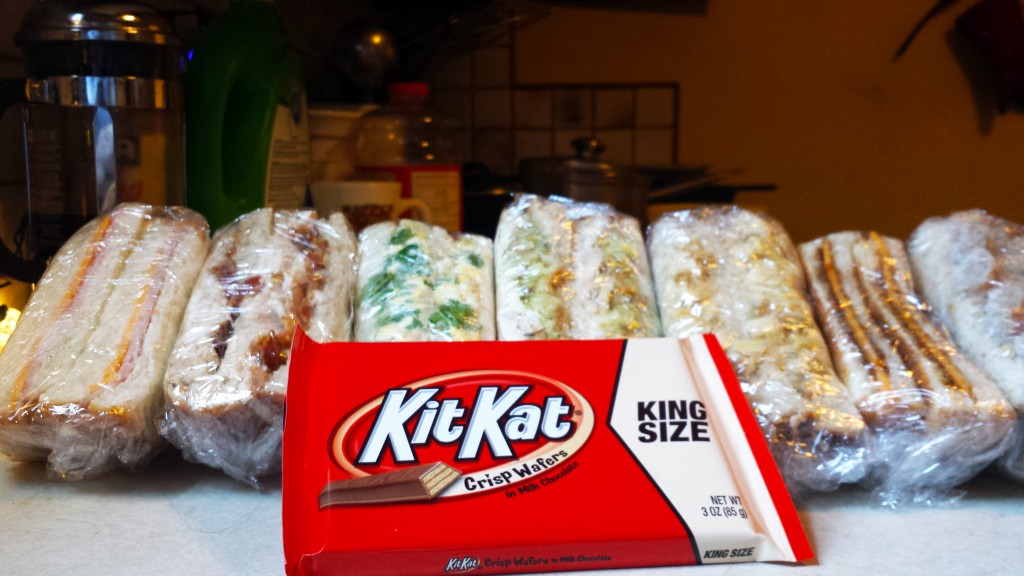

I like sandwiches.
I like a lot of other things too but sandwiches are pretty great


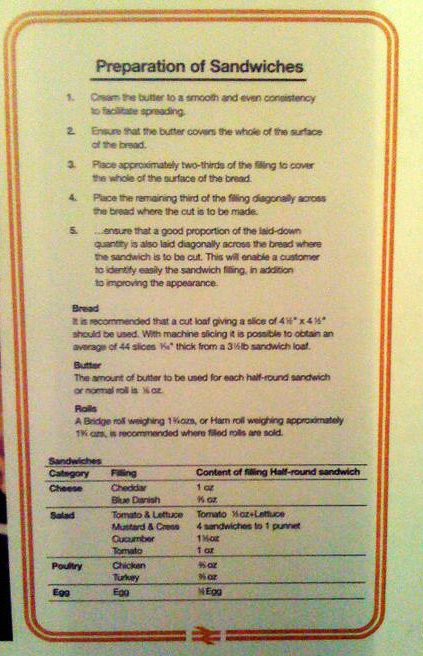
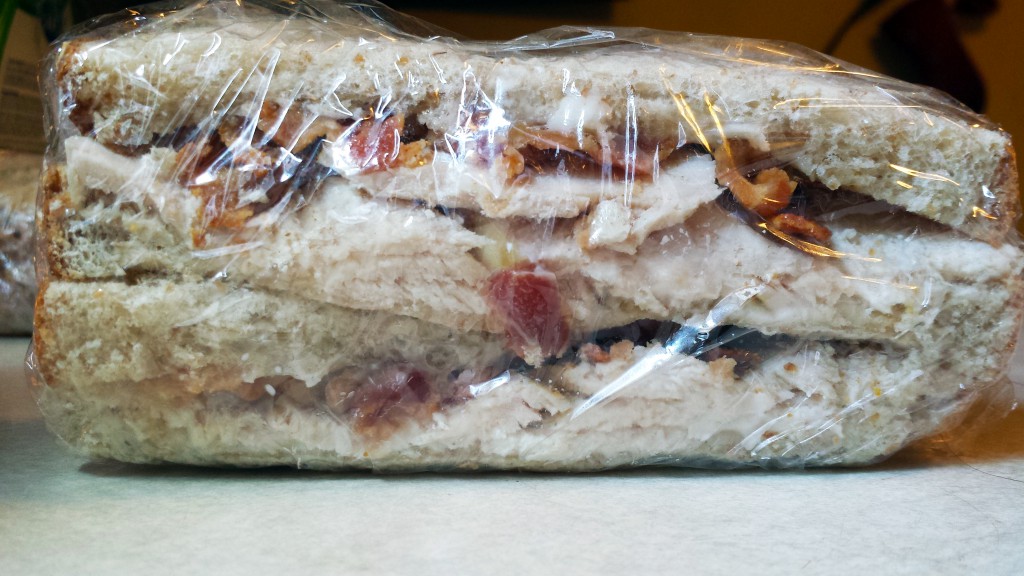
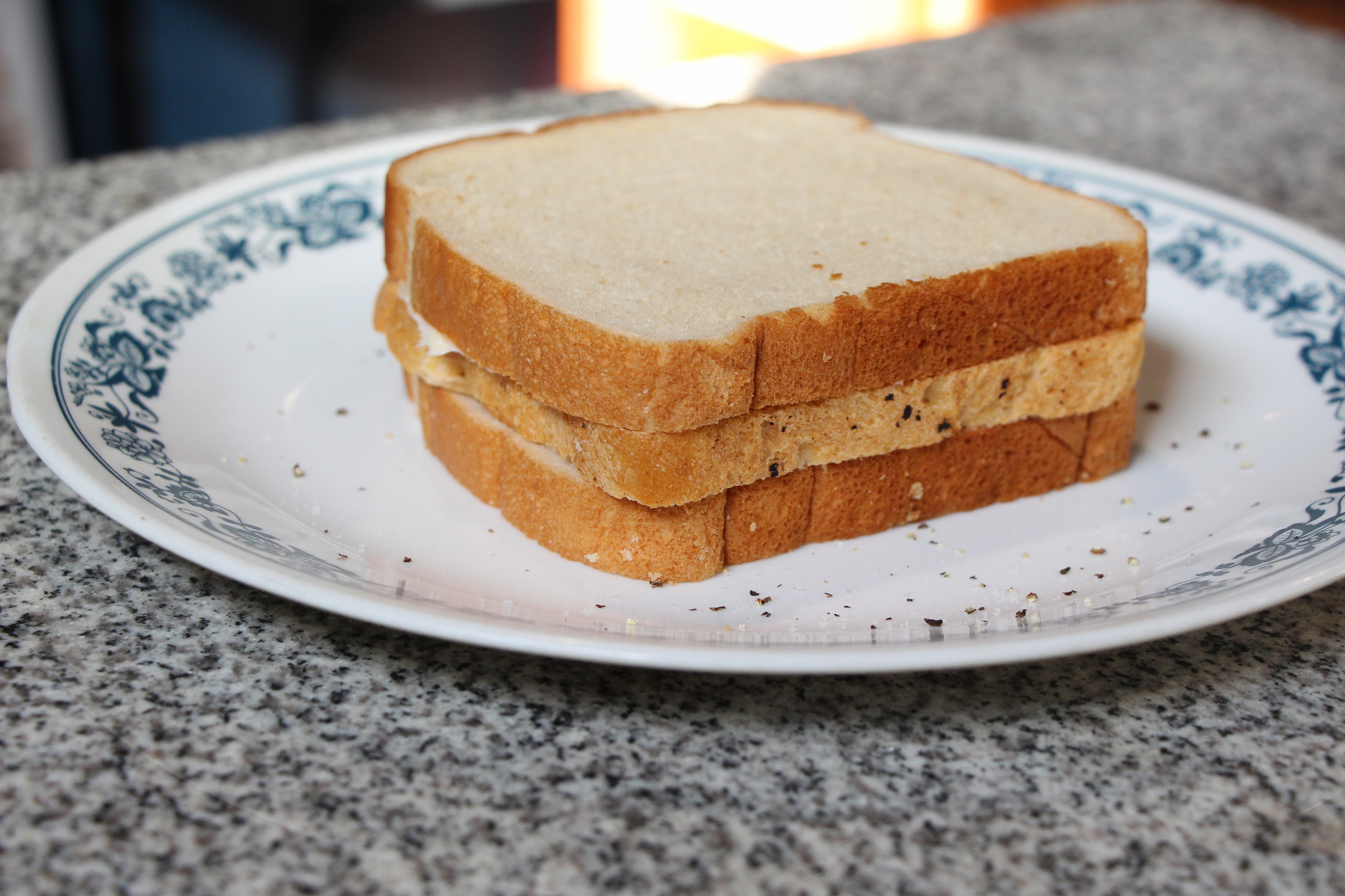








Jim, “cress” is indeed watercress. You can often find it at your local farmer’s market, but probably not in the middle of winter. It may be at Whole Foods or other fancy pants supermarkets as well.
Cress and watercress are not the same thing
https://en.wikipedia.org/wiki/Garden_cress aka Salad Cress
“the edible plant known as cress, not to be confused with watercress.”
but “genetically related to watercress and mustard, sharing their peppery, tangy flavour and aroma.”
“In the United Kingdom, cut cress shoots are commonly used in sandwiches with boiled eggs, mayonnaise and salt.”
Both are sold in most UK supermarkets, eg http://www.tesco.com
FWIW, in my experience cress is a *lot* more peppery than rocket, which might’ve made up for the lack of mustard, maybe? I don’t know that I know of a green that has the equivalent amount of pepperiness.
Congrats on this one – it doesn’t look like a whole lot of fun.
Thanks for the cress comments. I actually read a bit about cress and looked for it but couldn’t find it in the admittedly few markets I visited. The “What the hell is cress” thing was more frustration than ignorance, and also because I thought it was funny.
Grace, I actually had kind of a fun time researching and writing this post. Maybe the actual eating part wasn’t that fun 🙂
Hi Jim this is Steve’s hippy Mum (mom) just wanted to say that I really enjoyed reading about you and your families experiences tasting British sandwiches ! It really made me laugh a lot 🙂 I read it to Steve’s hippy Dad and he laughed too! Yep, BR sandwiches were pretty bad 🙁 I only eat them on long train journeys to visit my relatives in Manchester. The other version could sometimes be found in BR cafés on train stations, they were usually stale with turned up corners:( couple of things, when making Marmite sandwiches (I know you won’t be doing this judging from family reactions) but don’t put cheese with Marmite and don’t spread too thickly:/ Marmite is best on toast I think:) Regarding cress, you did investigate so you may know that it is a relative of watercress, they both have a peppery taste. However it grows really quickly and is usually grown in a small container and you can cut it with scissors and sometimes more will grow up( if you are lucky) ! Kids used to grow it at Elementary school on damp kitchen paper as an experiment to show how seeds grow!. It has fallen out of favour now and you will find watercress or rocket(arugula) in sandwiches nowadays:) one last thing in that BR list of sandwich ingredients it mentioned a punnet of mustard and cress? A punnet is a small throwaway container used in supermarkets and the mustard mentioned is sprouted mustard seeds grown in with the cress seeds:) my fav sarnie ( short name for sandwich) when visiting England is a prawn and mayo or an egg, mayo and watercress:) usually bought as Steve mentioned from Marks and Spencer. Good luck with your writing I will being checking in to read more interesting sandwich stories:)
oh wow, thanks for your comment! The further background on cress is great; growing some at home sounds like a fun project for the kids, if I could find seeds. I’ll have to look. I did contemplate making a prawn & mayo sandwich (I have a couple bags of shrimp in the freezer actually), along with a few others I found independently (like cheese and pickle which sounded intriguing) but I figured I had too many sandwiches for this post already.
I made some marmite toast last night by creaming a pat of butter and mixing a little dab of marmite into it before spreading it on the toast. It was much better, but still pretty intense and salty. Maybe starting with unsalted butter would be better. I’ve got too many friends in GB, Australia, & NZ giving me crap about not liking it to not give it another chance.
I hope you enjoy the rest of the site too!
Just reread the Hitchhiker’s Guide books and Douglas Adams had some other great sandwich quotes. Not gonna hit all of ’em right now–need to save a few for the next time I write about British sandwiches–but this one made me think of this post:
“There is a feeling which persists in England that making a sandwich interesting, attractive, or in any way pleasant to eat is something sinful that only foreigners do.”
Marmite is almost impossible to explain to anyone from outside the UK so I’m not surprised it didn’t go down well.
The incredibly light spreading, almost as if it’s a seasoning, is a skill developed over years of British life. It’s not an amateur’s spread.
I prefer my marmite on cold toast. Best to let the toast go cold and very crispy first, then spread with a substantially thick layer of cold butter. Then a thin layer of marmite. As mentioned above, there is a technique to applying the correct amount, we used to say “just show it to the marmite”.
British Rail sandwiches weren’t in my opinion very appetising and to tell you the truth I would have chosen bland fillings such as cheese, turkey, chicken, beef or pork sausage.